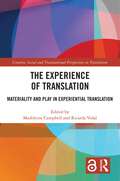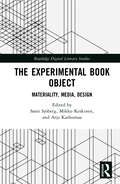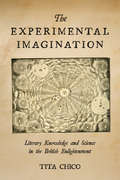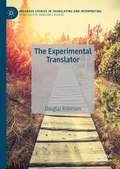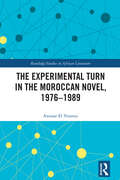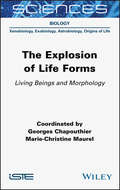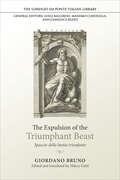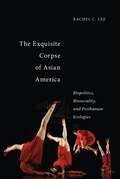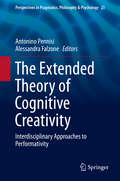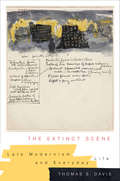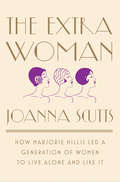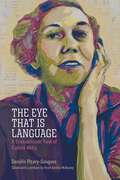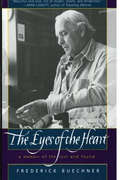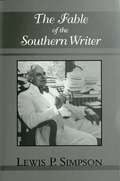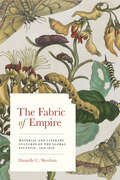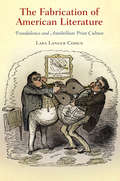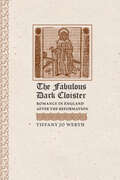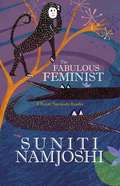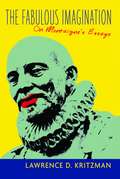- Table View
- List View
The Experience of Translation: Materiality and Play in Experiential Translation (Creative, Social and Transnational Perspectives on Translation)
by Madeleine CampbellCampbell, Vidal and their contributors expand the notion of translation beyond linguistic, modal and medial borders to embrace posthumanist perspectives through a holistic experiential epistemology which envisions translation as engaged, situated social practice.The first of two volumes, this book focuses on questions of materiality and play. Drawing together contributions on theory, methodology and practice from translators, scholars and practitioners working in the creative and performing arts, this book explores how contemporary, experiential acts of interpretation, mediation and negotiation can serve to bridge social and cultural discontinuities across time and space. These range from ancestral past to digital present, from rural to urban environments across the globe. Experiential translation applies a transdisciplinary lens to problematize views of translation and untranslatability traditionally bound by structuralist frames of reference and the reserve of professional linguistic translation. The chapters in this book apply this experiential lens to understand a pluriverse of creative translation practices where the translator’s subject position in relation to the ‘original’ is transformed by the role of experimentation, creativity and play. This book and its companion volume The Translation of Experience: Cultural Artefacts in Experiential Translation will be of particular interest to translators and arts practitioners, scholars and researchers in the transdisciplinary field of humanities.Funding: This work was supported by UKRI under AHRC Grant AH/V008234/1, awarded to Ricarda Vidal, King’s College London (Principal Investigator) and Madeleine Campbell, University of Edinburgh (Co-Investigator).
The Experimental Book Object: Materiality, Media, Design (Routledge Digital Literary Studies)
by Sami Sjöberg Mikko Keskinen Arja KarhumaaThe Experimental Book Object shows why and how books matter in the 21st century. Digital and audio platforms are commonplace, and other fields of art beyond literature have increasingly embraced books and publication as their medium of choice. Nevertheless, the manifold book object persists and continues to inspire various types of experimentation. This volume sets forth an unprecedented approach where literary and media theory are entangled with design practitioners’ artistic research and process descriptions. By probing the paradigm of the codex, this collection of essays focuses on historical and contemporary experimentation that has challenged what books are and could be from the perspectives of materiality, mediation, and visual and typographic design. Investigations into less-studied areas and cases of performativity demonstrate what experimental books do by interacting with their systemic and cultural environments. The volume offers a multifaceted and multidisciplinary view of the book object, the book design and publishing processes, and their significance in the digital age.
The Experimental Imagination: Literary Knowledge and Science in the British Enlightenment
by Tita ChicoChallenging the "two cultures" debate, The Experimental Imagination tells the story of how literariness came to be distinguished from its epistemological sibling, science, as a source of truth about the natural and social worlds in the British Enlightenment. Tita Chico shows that early science relied on what she calls literary knowledge to present its experimental findings. More radically, she contends that science was made intellectually possible because its main discoveries and technologies could be articulated in literary terms. While early scientists deployed metaphor to describe the phenomena they defined and imagination to cast themselves as experimentalists, literary writers used scientific metaphors to make the case for the epistemological superiority of literary knowledge. Drawing on literature as well as literary language, tropes, and interpretive methods, literary knowledge challenges our dominant narrative of the scientific revolution as the sine qua non of epistemological innovation in the British Enlightenment. With its recourse to imagination as a more reliable source of truth than any empirical account, literary knowledge facilitates a redefinition of authority and evidence, as well as of the self and society, implicitly articulating the difference that would come to distinguish the arts and sciences.
The Experimental Translator (Palgrave Studies in Translating and Interpreting)
by Douglas RobinsonThis book celebrates experimental translation, taking a series of exploratory looks at the hypercyborg translator, the collage translator, the smuggler translator, and the heteronymous translator. The idea isn’t to legislate traditional translations out of existence, or to “win” some kind of literary competition with the source text, but an exuberant participation in literary creativity. Turns out there are other things you can do with a great written work, and there is considerable pleasure to be had from both the doing and the reading of such things. This book will be of interest to literary translation studies researchers, as well as scholars and practitioners of experimental creative writing and avant-garde art, postgraduate translation students and professional (literary) translators.
The Experimental Turn in the Moroccan Novel, 1976-1989 (Routledge Studies in African Literature)
by Anouar El YounssiThe Experimental Turn in the Moroccan Novel, 1976-1989 examines the trajectory of the Moroccan experimental novel and makes a link between its emergence in the early-mid 1970s and the Arab defeat in the six-day war with Israel in 1967.Drawing on works by Muḥammad Barrādah, ʿAbdullāh al-ʿArwī, Aḥmad al-Madīnī, and others, the book contends that the Moroccan experimental novel reflects an historic turning point and transitional cultural landscape. It further shows that the experimental novel laid the ground for a different vision of literature, an important feature of which was the intent to surpass the traditional realist model as executed by Moroccan novelist ʿAbdulkarīm Ghallāb (1919–2017) and Egyptian Nobel laureate Najīb Maḥfūẓ (1911–2006). This new vision of literature seeks to create new discursive spheres for the treatment of the social and the political.This book will be an important contribution to debates around Moroccan/Arabic/Maghrebi literature, as well as to the field of literary experimentalism more broadly.
The Explosion of Life Forms: Living Beings and Morphology
by Marie-Christine Maurel Georges ChapouthierOne of the essential characteristics of living beings is the explosion of variety in their forms that is intrinsically linked to the diversity of the environments they have adapted to. This book, the result of collaboration between international specialists, analyzes the multiplicity of these morphologies. It explores the origin of forms, their role in defining living things, and the relationship between form and function. It exposes the role of genes and epigenetics and examines the forms of bacteria, protists and plants. The Explosion of Life Forms also studies the memory of animals and their sensory processes, the forms of robots (built in the image of living things), and medical technologies aimed at restoring damaged living forms. Finally, this work questions a common principle of construction in the diversity of forms, as well as the idea of an abandonment of the form, a possible hidden defect of some modern philosophies.
The Expulsion of the Triumphant Beast: Spaccio della bestia trionfante (Lorenzo Da Ponte Italian Library)
by Giordano BrunoPublished in London in 1584, The Expulsion of the Triumphant Beast is Giordano Bruno’s first work of moral philosophy. It is dedicated with a long Explicatory Letter to Elizabeth I’s most cultured courtier, Sir Philip Sidney. It is a book about moral reform, expelling the beasts of evil, and putting virtues in their place. Its theme is presented as an allegorical drama in which ancient myths assume modern meanings questioning the ways in which moral and religious reform have been conceived in both the ancient world and the cultures of Renaissance Europe. This new Italian text, based on the original printed text of 1584 held in the British Library, presents a less modernized version than those presently available, while maintaining a modern page format. The aim is to provide a text closer to the sound of Bruno’s original mix of classical Tuscan Italian and Neapolitan dialectical forms. This edition also presents a new translation designed to render Bruno’s complex and baroque Italian into easily readable modern English. Hilary Gatti introduces The Expulsion of the Triumphant Beast, underlining Bruno’s meta-literary reflection on the nature of allegory and myth as well as the dramatic structure of his text. Drama, philosophy, and religion combine in this work to give an epic dimension to the perennial cosmic battle between evil and good.
The Exquisite Corpse of Asian America: Biopolitics, Biosociality, and Posthuman Ecologies (Sexual Cultures #16)
by Rachel C. LeeWinner of the 2016 Association for Asian American Studies Award for Best Book in Cultural StudiesThe Exquisite Corpse ofAsian Americaaddresses this central question: if race has been settled as a legal or socialconstruction and not as biological fact, why do Asian American artists,authors, and performers continue to scrutinize their body parts? Engagingnovels, poetry, theater, and new media from both the U.S. andinternationally—such as Kazuo Ishiguro’s science fiction novel Never Let MeGo or Ruth Ozeki’s My Year of Meats and exhibits like that of BodyWorlds in which many of the bodies on display originated from Chinese prisons—RachelC. Lee teases out the preoccupation with human fragments and posthumanecologies in the context of Asian American cultural production and theory. Sheunpacks how the designation of “Asian American” itself is a mental constructthat is paradoxically linked to the biological body.Through chapters that each use a body part as springboard forreading Asian American texts, Lee inaugurates a new avenue of research onbiosociality and biopolitics within Asian American criticism, focused on theliterary and cultural understandings of pastoral governmentality, the divergentscales of embodiment, and the queer (cross)species being of racial subjects.She establishes an intellectual alliance and methodological synergy betweenAsian American studies and Science and Technology Studies (STS), biocultures,medical humanities, and femiqueer approaches to family formation, carework,affect, and ethics. In pursuing an Asian Americanist critique concerned withspeculative and real changes to human biologies, she both produces innovationwithin the field and demonstrates the urgency of that critique to otherdisciplines.
The Extended Mind
by Robert K. LoganThe ability to communicate through language is such a fundamental part of human existence that we often take it for granted, rarely considering how sophisticated the process is by which we understand and make ourselves understood. In The Extended Mind, acclaimed author Robert K. Logan examines the origin, emergence, and co-evolution of language, the human mind, and culture. Building on his previous study, The Sixth Language (2000) and making use of emergence theory, Logan seeks to explain how language emerged to deal with the complexity of hominid existence brought about by tool-making, control of fire, social intelligence, coordinated hunting and gathering, and mimetic communication. The resulting emergence of language, he argues, signifies a fundamental change in the functioning of the human mind - a shift from percept-based thought to concept-based thought. From the perspective of the Extended Mind model, Logan provides an alternative to and critique of Noam Chomsky's approach to the origin of language. He argues that language can be treated as an organism that evolved to be easily acquired, obviating the need for the hard-wiring of Chomsky's Language Acquisition Device. In addition Logan shows how, according to this model, culture itself can be treated as an organism that has evolved to be easily attained, revealing the universality of human culture as well as providing an insight as to how altruism might have originated. Bringing timely insights to a fascinating field of inquiry, The Extended Mind will be sure to find a wide readership.
The Extended Theory of Cognitive Creativity: Interdisciplinary Approaches to Performativity (Perspectives in Pragmatics, Philosophy & Psychology #23)
by Antonino Pennisi Alessandra FalzoneThis edited volume focuses on the hypothesis that performativity is not a property confined to certain specific human skills, or to certain specific acts of language, nor an accidental enrichment due to creative intelligence. Instead, the executive and motor component of cognitive behavior should be considered an intrinsic part of the physiological functioning of the mind, and as endowed with self-generative power. Performativity, in this theoretical context, can be defined as a constituent component of cognitive processes. The material action allowing us to interact with reality is both the means by which the subject knows the surrounding world and one through which he experiments with the possibilities of his body. This proposal is rooted in models now widely accepted in the philosophy of mind and language; in fact, it focuses on a space of awareness that is not in the individual, or outside it, but is determined by the species-specific ways in which the body acts on the world. This theoretical hypothesis will be pursued through the latest interdisciplinary methodology typical of cognitive science, that coincide with the five sections in which the book is organized: Embodied, enactivist, philosophical approaches; Aesthetics approaches; Naturalistic and evolutionary approaches; Neuroscientific approaches; Linguistics approaches. This book is intended for: linguists, philosophers, psychologists, cognitive scientists, scholars of art and aesthetics, performing artists, researchers in embodied cognition, especially enactivists and students of the extended mind.
The Extinct Alphabet Book (Jerry Pallotta's Alphabet Books)
by Jerry PallottaLearn about the five-eyed Opabinia and the Four-toed Horse. Speculate about the life of the Jamaican Long-tongued Bat. Discover the fate of the beautiful Quagga. But don't look for any dinosaurs in this book. There aren't any!Millions of creatures other than dinosaurs are now extinct. In true alphabet book tradition, the author has found twenty-six of the most extraordinary past-inhabitants of the Earth.Jerry Pallotta and Ralph Masiello team up to provide exciting, accurate text and illustrations filled with unusual and amusing insight that will satisfy fans of all ages.
The Extinct Scene
by Thomas S. DavisIn 1935, the English novelist Stephen Spender wrote that the historical pressures of his era should "turn the reader's and writer's attention outwards from himself to the world." Combining historical, formalist, and archival approaches, Thomas S. Davis examines late modernism's decisive turn toward everyday life, locating in the heightened scrutiny of details, textures, and experiences an intimate attempt to conceptualize geopolitical disorder. The Extinct Scene reads a range of mid-century texts, films, and phenomena that reflect the decline of the British Empire and seismic shifts in the global political order. Davis follows the rise of documentary film culture and the British Documentary Film Movement, especially the work of John Grierson, Humphrey Jennings, and Basil Wright. He then considers the influence of late modernist periodical culture on social attitudes and customs, and, through a more nuanced understanding of the period, conducts original analyses of novels by Virginia Woolf, Christopher Isherwood, and Colin MacInnes; the interwar travel narratives of W. H. Auden, Christopher Isherwood, and George Orwell; the wartime gothic fiction of Elizabeth Bowen; the poetry of H. D.; the sketches of Henry Moore; and the postimperial Anglophone Caribbean works of Vic Reid, Sam Selvon, and George Lamming. By considering this varied group of writers, artists, and cultural leaders, Davis recasts late modernism as an art of scale: by detailing the particulars of everyday life, the movement could better project the large-scale undoing of history.
The Extinct Scene: Late Modernism and Everyday Life (Modernist Latitudes)
by Thomas DavisIn 1935, the English writer Stephen Spender wrote that the historical pressures of his era should "turn the reader's and writer's attention outwards from himself to the world." Combining historical, formalist, and archival approaches, Thomas S. Davis examines late modernism's decisive turn toward everyday life, locating in the heightened scrutiny of details, textures, and experiences an intimate attempt to conceptualize geopolitical disorder.The Extinct Scene reads a range of mid-century texts, films, and phenomena that reflect the decline of the British Empire and seismic shifts in the global political order. Davis follows the rise of documentary film culture and the British Documentary Film Movement, especially the work of John Grierson, Humphrey Jennings, and Basil Wright. He then considers the influence of late modernist periodical culture on social attitudes and customs, and presents original analyses of novels by Virginia Woolf, Christopher Isherwood, and Colin MacInnes; the interwar travel narratives of W. H. Auden, Christopher Isherwood, and George Orwell; the wartime gothic fiction of Elizabeth Bowen; the poetry of H. D.; the sketches of Henry Moore; and the postimperial Anglophone Caribbean works of Vic Reid, Sam Selvon, and George Lamming. By considering this group of writers and artists, Davis recasts late modernism as an art of scale: by detailing the particulars of everyday life, these figures could better project large-scale geopolitical events and crises.
The Extra Woman: How Marjorie Hillis Led A Generation Of Women To Live Alone And Like It
by Joanna ScuttsFrom the flapper to The Feminine Mystique, a cultural history of single women in the city through the reclaimed life of glamorous guru Marjorie Hillis. You’ve met the extra woman: she’s sophisticated, she lives comfortably alone, she pursues her passions unabashedly, and—contrary to society’s suspicions—she really is happy. Despite multiple waves of feminist revolution, today’s single woman is still mired in judgment or, worse, pity. But for a brief, exclamatory period in the late 1930s, she was all the rage. A delicious cocktail of cultural history and literary biography, The Extra Woman transports us to the turbulent and transformative years between suffrage and the sixties, when, thanks to the glamorous grit of one Marjorie Hillis, single women boldly claimed and enjoyed their independence. Marjorie Hillis, pragmatic daughter of a Brooklyn preacher, was poised for reinvention when she moved to the big city to start a life of her own. Gone were the days of the flirty flapper; ladies of Depression-era New York embraced a new icon: the independent working woman. Hillis was already a success at Vogue when she published a radical self-help book in 1936: Live Alone and Like It: A Guide for the Extra Woman. With Dorothy Parker–esque wit, she urged spinsters, divorcées, and “old maids” to shed derogatory labels and take control of their lives, and her philosophy became a phenomenon. From the importance of a peignoir to the joy of breakfast in bed (alone), Hillis’s tips made single life desirable and chic. In a style as irresistible as Hillis’s own, Joanna Scutts, a leading cultural critic, explores the revolutionary years following the Live-Alone movement, when the status of these “brazen ladies” peaked and then collapsed. Other innovative lifestyle gurus set similar trends that celebrated guiltless female independence and pleasure: Dorothy Draper’s interior design smash, Decorating Is Fun! transformed apartments; Irma Rombauer’s warm and welcoming recipe book, The Joy of Cooking, reassured the nervous home chef that she, too, was capable of decadent culinary feats. By painting the wider picture, Scutts reveals just how influential Hillis’s career was, spanning decades and numerous best sellers. As she refashioned her message with every life experience, Hillis proved that guts, grace, and perseverance would always be in vogue. With this vibrant examination of a remarkable life and profound feminist philosophy, Joanna Scutts at last reclaims Marjorie Hillis as the original queen of a maligned sisterhood. Channeling Hillis’s charm, The Extra Woman is both a brilliant exposé of women who forged their independent paths before the domestic backlash of the 1950s trapped them behind picket fences, and an illuminating excursion into the joys of fashion, mixology, decorating, and other manifestations of shameless self-love.
The Eye That Is Language: A Transatlantic View of Eudora Welty (Critical Perspectives on Eudora Welty)
by Danièle Pitavy-SouquesDanièle Pitavy-Souques (1937–2019) was a European powerhouse of Welty studies. In this collection of essays, Pitavy-Souques pours new light on Welty’s view of the world and her international literary import, challenging previous readings of Welty’s fiction, memoir, and photographs in illuminating ways. The nine essays collected here offer scholars, critics, and avid readers a new understanding and enjoyment of Welty’s work. The volume explores beloved stories in Welty’s masterpiece The Golden Apples, as well as “A Curtain of Green,” “Flowers for Marjorie,” “Old Mr. Marblehall,” “A Still Moment,” “Livvie,” “Circe,” “Kin,” and The Optimist’s Daughter, One Writer’s Beginnings, and One Time, One Place. Essays include “Technique as Myth: The Structure of The Golden Apples” (1979), “A Blazing Butterfly: The Modernity of Eudora Welty” (1987), and others written between 2000 and 2018. Together, they reveal and explain Welty’s brilliance for employing the particular to discover the universal. Pitavy-Souques, who briefly lived in and often revisited the South, met with Welty several times in her Jackson, Mississippi, home. Her readings draw on the visual arts, European theorists, and styles of modernism, postmodernism, surrealism, as well as the baroque and the gothic. The included essays reflect Pitavy-Souques’s European education, her sophisticated understanding of intellectual theories and artistic movements abroad, and her passion for the literary achievement of women of genius. The Eye That Is Language: A Transatlantic View of Eudora Welty reveals the way in which Welty’s narrative techniques broaden her work beyond southern myths and mysteries into a global perspective of humanity.
The Eye of the Story
by Eudora WeltyThe Eye of the Story is a priceless collection of essays. A lot of informative aspects of writing with reference to great writers like Jane Austen, Virginia Woolf and many others have been included in this book.
The Eyes of the Heart: A Memoir of the Lost and Found
by Frederick BuechnerFrom critically acclaimed author and Pulitzer Prize runner-up Frederick Buechner comes another powerfully honest memoir, The Eyes of the Heart. Full of poinant insights into his most personal relationships, this moving account traces how the author was shaped as much by his family's secrets as by its celebrations.Within the innermost chambers of his consciousness, Buechner, in his characteristically self-searching style, explores the mysteries and truths behind his deepest connections to family, friends, and mentors. Extraordinarily moving, this memoir follows not chronology but the converging paths of Buechner's imagination and memory.Buechner invites us into his library-his own Magic Kingdom, Surrounded by his beloved books and treasures, we discover how they serve as the gateway to Buechner's mind and heart. He draws the reader into his recollections, moving seamlessly from reminiscence to contemplation. Buechner recounts events such as the tragic suicide of his father and its continual fallout on his life, intimate and little-known details about his deep friendship with the late poet James Merrill, and his ongoing struggle to understand the complexities of his relationship to his mother.This cast of characters comprised of Buechner's relatives and loved ones is brought to vibrant life by his peerless writing and capacity to probe the depths of his own consciousness. Buechner visits his past with an honest eye and a heart open to the most painful and life-altering of realizations. heartbreaking and enlightening, The Eyes of the Heart is a treasure for any who have ever pondered the meaning and mystery of their own past.As "one of our finest writers," according to author Annie Dillard, Frederick Buechner provides yet another chapter in the tale of his life in this gripping memoir tracing the complicated roots and path of his inner life and family, with their multitude of intersections." The Eyes of the Heart stands as a touching testimonial to the significance of kinship to the author as well as to the legions of readers who have come to regard him as one of their own.
The Fable of the Southern Writer
by Lewis P. Simpson"With a breadth and depth unsurpassed by any other cultural historian of the South, Lewis Simpson examines the writing of southerners Thomas Jefferson, John Randolph, Mark Twain, Robert Penn Warren, Allen Tate, William Faulkner, Elizabeth Madox Roberts, Arthur Crew Inman, William Styron, and Walker Percy. Simpson offers challenging essays of easy erudition blessedly free of academic jargon.... [They] do not propose to support an overall thesis, but simply explore the southern writer's unique relationship with his or her region, bereft of myth and tradition, in the grasp of science and history." -- Library Journal
The Fabric of Empire: Material and Literary Cultures of the Global Atlantic, 1650-1850 (Studies in Early American Economy and Society from the Library Company of Philadelphia)
by Danielle C. SkeehanRevealing the entangled lives of texts and textiles in the early modern Atlantic world."Textiles are the books that the colony was not able to burn."—Asociación Femenina para el Desarrollo de Sacatepéquez (AFEDES)A history of the book in the Americas, across deep time, would reveal the origins of a literary tradition woven rather than written. It is in what Danielle Skeehan calls material texts that a people's history and culture is preserved, in their embroidery, their needlework, and their woven cloth. In defining textiles as a form of cultural writing, The Fabric of Empire challenges long-held ideas about authorship, textuality, and the making of books. It is impossible to separate text from textiles in the early modern Atlantic: novels, newspapers, broadsides, and pamphlets were printed on paper made from household rags. Yet the untethering of text from textile served a colonial agenda to define authorship as reflected in ink and paper and the pen as an instrument wielded by learned men and women. Skeehan explains that the colonial definition of the book, and what constituted writing and authorship, left colonial regimes blind to nonalphabetic forms of media that preserved cultural knowledge, history, and lived experience. This book shifts how we look at cultural objects such as books and fabric and provides a material and literary history of resistance among the globally dispossessed.Each chapter examines the manufacture and global circulation of a particular type of cloth alongside the complex print networks that ensured the circulation of these textiles, promoted their production, petitioned for or served to curtail the rights of textile workers, facilitated the exchange of textiles for human lives, and were, in turn, printed and written on surfaces manufactured from broken-down linen and cotton fibers. Bringing together methods and materials traditionally belonging to literary studies, book history, and material culture studies, The Fabric of Empire provides a new model for thinking about the different media, languages, literacies, and textualities in the early Atlantic world.
The Fabrication of American Literature
by Lara Langer CohenLiterary histories typically celebrate the antebellum period as marking the triumphant emergence of American literature. But the period's readers and writers tell a different story: they derided literature as a fraud, an imposture, and a humbug, and they likened it to inflated currency, land bubbles, and quack medicine.Excavating a rich archive of magazine fiction, verse satires, comic almanacs, false slave narratives, minstrel song sheets, and early literary criticism, and revisiting such familiar figures as Edgar Allan Poe, Davy Crockett, Fanny Fern, and Herman Melville, Lara Langer Cohen uncovers the controversies over literary fraudulence that plagued these years and uses them to offer an ambitious rethinking of the antebellum print explosion. She traces the checkered fortunes of American literature from the rise of literary nationalism, which was beset by accusations of puffery, to the conversion of fraudulence from a national dilemma into a sorting mechanism that produced new racial, regional, and gender identities. Yet she also shows that even as fraudulence became a sign of marginality, some authors managed to turn their dubious reputations to account, making a virtue of their counterfeit status. This forgotten history, Cohen argues, presents a dramatically altered picture of American literature's role in antebellum culture, one in which its authority is far from assured, and its failures matter as much as its achievements.
The Fabulous Dark Cloister: Romance in England after the Reformation
by Tiffany J. WerthRomances were among the most popular books in the sixteenth and seventeenth centuries among both Protestant and Catholic readers. Modeled after Catholic narratives, particularly the lives of saints, these works emphasized the supernatural and the marvelous, themes commonly associated with Catholicism. In this book, Tiffany Jo Werth investigates how post-Reformation English authors sought to discipline romance, appropriating its popularity while distilling its alleged Catholic taint. Charged with bewitching readers, especially women, into lust and heresy, romances sold briskly even as preachers and educators denounced them as papist. Protestant reformers, as part of their broader indictment of Catholicism, sought to redirect certain elements of the Christian tradition, including this notorious literary genre. Werth argues that through the writing and circulation of romances, Protestants repurposed their supernatural and otherworldly motifs in order to "fashion," as Edmund Spenser wrote, godly "vertuous" readers. Through careful examinations of the period’s most renowned romances—Sir Philip Sidney’s The Countess of Pembrokes Arcadia, Spenser’s The Faerie Queen, William Shakespeare’s Pericles, and Lady Mary Wroth’s Urania—Werth illustrates how post-Reformation writers struggled to transform the literary genre. As a result, the romance, long regarded as an archetypal form closely allied with generalized Christian motifs, emerged as a central tenet of the religious controversies that divided Renaissance England.
The Fabulous Feminist
by Suniti NamjoshiIt was on a sabbatical in England in the late seventies that Suniti Namjoshi discovered feminism-or rather, she discovered that other feminists existed, and many among them shared her thoughts and doubts, her questions and visions. Since then, she has been writing-fables, poetry, prose autobiography, children's stories-about power, about inequality, about oppression, effectively using the power of language and the literary tradition to expose what she finds absurd and unacceptable. This new collection brings together in one volume a huge range of Namjoshi's writings, starting with her classic collection, Feminist Fables, and coming right up to her latest work.
The Fabulous Imagination: On Montaigne's Essays
by Lawrence D. KritzmanThis is one of the few books on Montaigne that fuses analytical skill with humane awareness of why Montaigne matters. Harold Bloom, Sterling Professor of Humanities, Yale University; In this exhilarating and learned book on Montaigne's essays, Lawrence D. Kritzman contemporizes the great writer. Reading him from today's deconstructive America, Kritzman discovers Montaigne always already deep into a dialogue with Jacques Derrida and psychoanalysis. One cannot but admire this fabulous act of translation. -Helene Cixous Throughout his career, Lawrence D. Kritzman has demonstrated an intimate knowledge of Montaigne's essays and an engagement with French philosophy and critical theory. The Fabulous Imagination sheds precious new light on one of the founders of modern individualism and on his crucial quest for self-knowledge. -Jean Starobinski, professor emeritus of French literature, University of Geneva Michel de Montaigne's (1533-1592) Essais was a profound study of human subjectivity. More than three hundred years before the advent of psychoanalysis, Montaigne embarked on a remarkable quest to see and imagine the self from a variety of vantages. Through the questions How shall I live? How can I know myself? he explored the significance of monsters, nightmares, and traumatic memories; the fear of impotence; the fragility of gender; and the act of anticipating and coping with death. In this book, Lawrence D. Kritzman traces Montaigne's development of the Western concept of the self. For Montaigne, imagination lies at the core of an internal universe that influences both the body and the mind. Imagination is essential to human experience. Although Montaigne recognized that the imagination can confuse the individual, "the fabulous imagination" can be curative, enabling the mind's "I" to sustain itself in the face of hardship. Kritzman begins with Montaigne's study of the fragility of gender and its relationship to the peripatetic movement of a fabulous imagination. He then follows with the essayist's examination of the act of mourning and the power of the imagination to overcome the fear of death. Kritzman concludes with Montaigne's views on philosophy, experience, and the connection between self-portraiture, ethics, and oblivion. His reading demonstrates that the mind's I, as Montaigne envisioned it, sees by imagining that which is not visible, thus offering an alternative to the logical positivism of our age.
The Fabulous Imagination: On Montaigne's Essays
by Lawrence D. Kritzman"This is one of the few books on Montaigne that fuses analytical skill with humane awareness of why Montaigne matters."-Harold Bloom, Sterling Professor of Humanities, Yale University"In this exhilarating and learned book on Montaigne's essays, Lawrence D. Kritzman contemporizes the great writer. Reading him from today's deconstructive America, Kritzman discovers Montaigne always already deep into a dialogue with Jacques Derrida and psychoanalysis. One cannot but admire this fabulous act of translation."-Hélène Cixous"Throughout his career, Lawrence D. Kritzman has demonstrated an intimate knowledge of Montaigne's essays and an engagement with French philosophy and critical theory. The Fabulous Imagination sheds precious new light on one of the founders of modern individualism and on his crucial quest for self-knowledge."-Jean Starobinski, professor emeritus of French literature, University of GenevaMichel de Montaigne's (1533-1592) Essais was a profound study of human subjectivity. More than three hundred years before the advent of psychoanalysis, Montaigne embarked on a remarkable quest to see and imagine the self from a variety of vantages. Through the questions How shall I live? How can I know myself? he explored the significance of monsters, nightmares, and traumatic memories; the fear of impotence; the fragility of gender; and the act of anticipating and coping with death. In this book, Lawrence D. Kritzman traces Montaigne's development of the Western concept of the self. For Montaigne, imagination lies at the core of an internal universe that influences both the body and the mind. Imagination is essential to human experience. Although Montaigne recognized that the imagination can confuse the individual, "the fabulous imagination" can be curative, enabling the mind's "I" to sustain itself in the face of hardship. Kritzman begins with Montaigne's study of the fragility of gender and its relationship to the peripatetic movement of a fabulous imagination. He then follows with the essayist's examination of the act of mourning and the power of the imagination to overcome the fear of death. Kritzman concludes with Montaigne's views on philosophy, experience, and the connection between self-portraiture, ethics, and oblivion. His reading demonstrates that the mind's I, as Montaigne envisioned it, sees by imagining that which is not visible, thus offering an alternative to the logical positivism of our age.
